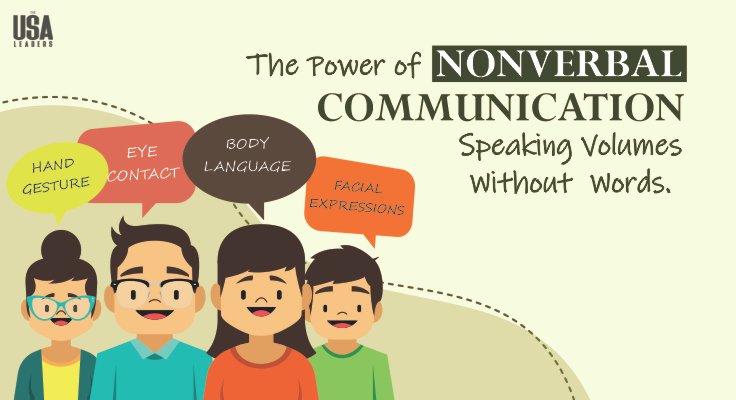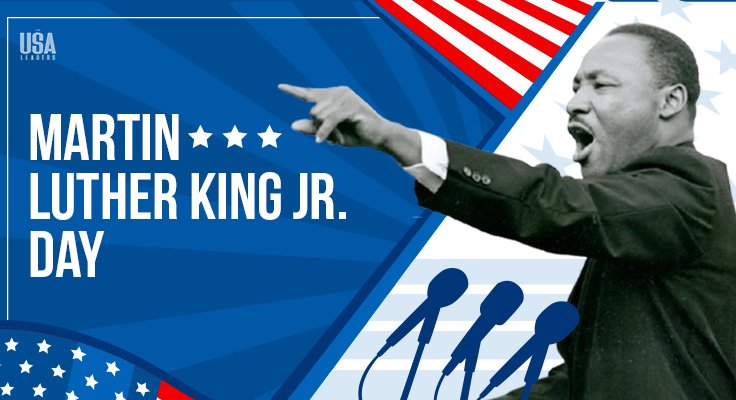Imagine you being a student in a school. All the students in your class are making noise. The teacher enters your classroom, she stands in front of the students. The students continue talking and after a while, they notice the teacher. The students calm down as they notice the teacher standing and the teacher has not yet uttered a single word.
How do you think that the teacher brought silence in the class by her own silence?
This is how effective nonverbal communication is!
Nonverbal communication can be a powerful leadership tool.
More than ever, efficient communication is essential in today’s fast-paced world. Nonverbal communication is just as important for communicating messages and emotions as verbal communication, even though verbal communication frequently takes center stage. This comprehensive resource examines the value of nonverbal communication in a variety of professional contexts, including multicultural teams, client encounters, leadership, and workplace relationships.
Professional environments place a high value on nonverbal communication. It can express feelings and interpersonal attitudes, either back or oppose what is being said, and enhance verbal communication. A kind smile, for example, might make a compliment seem even better, whereas a bitter tone may take away from an otherwise pleasant statement. You may improve your relationships, succeed more in your career, and have better interactions by being an expert in nonverbal communication.
Nonverbal cues have a big influence on job development and advancement in professional contexts. They have the power to shape how other people see us, which can impact how well we do in networking events, client meetings, and job interviews. For instance, keeping eye contact may show attentiveness and confidence, two crucial presentation abilities that might win over prospective customers or employers.
Understanding Nonverbal Communication.
Nonverbal communication, through elements like posture, facial expressions, and eye contact, significantly impacts how messages are received. It conveys emotions, intentions, and even credibility.
Components of Non Verbal Communication.
- Eye Contact.
- Facial Expressions.
- Gestures.
- Posture and Stance.
- Proximity and personal space.
- Touch.
- Tone of voice.
The significance of nonverbal cues in business interactions.
Understanding nonverbal communication in the workplace has two purposes.
- Managers successfully guide other workers and team members using nonverbal signals.
- Team members can convey information to people outside the company—whether they be rivals, clients, or coworkers in a related industry—by using nonverbal signals.
Nonverbal Communication and Leadership.
Leaders use nonverbal communication to influence and motivate.
1. A leader’s ability to inspire people comes from their nonverbal communication. Posture, gestures, and facial expressions all indicate confidence, compassion, and support. These signals promote a motivated and involved team by providing security and understanding. Hence non verbal communication can be used to motivate team members beyond words.
2. In leadership, authenticity isn’t only about what we say; it’s also about how we say it. Our nonverbal cues, including making eye contact and adopting an attentive listening position, help to establish credibility and trust. They convince our team that we care about their thoughts and welfare.
3. Leaders set the tone for their interactions with their team and, eventually, with consumers by how they treat them. A manager’s approach and body language can have a big impact on the culture of the business, which frequently filters down to the employees’ interactions with customers. Positive nonverbal communication builds confidence within the team and eventually improves experiences with customers.
By demonstrating acceptable nonverbal communication, we make sure that our team members can speak with people and represent the firm in the best possible way.
Key Nonverbal Communication Methods
- Eye Contact:
Making eye contact is essential to nonverbal communication since it’s a silent yet effective way to express understanding and feelings. However, what does eye contact actually mean? In a nutshell, it’s the instant that two people meet eyes and establish a nonverbal communication channel that goes beyond words. Eye contact can be used to convey confidence and attention.
This is why maintaining eye contact is important:
- Empathy-related brain circuits are activated by eye contact, according to research, which strengthens emotional bonds between people. We can mirror one other’s emotions and build our relationships with one another by maintaining eye contact.
- Making direct eye contact can strengthen one’s defenses against persuasive tactics and enable people to negotiate discussions with greater awareness and independence and convey confidence.
- It creates a sense of authority and empathy by projecting knowledge while exhibiting consideration for the responses of the audience.
- Facial Expressions:
“The face tells a story, and it is a story that has never been told before.” – Lucy Grealy
Emotions, attitudes, and thoughts are communicated through your facial expressions and body language. Squinting, eyebrow lifting, frowning, and smiling are a few examples. They are powerful because they can significantly affect how a conversation turns out.
Different kinds of emotions and facial expressions have different meanings.
- Smiling: A smile can convey warmth, friendliness, and transparency. It can be beneficial to start up a conversation and develop an effective connection with clients and coworkers.
- Frowning: Frowning can be used to express frustration, discontent, or irritation. It can indicate that they are unhappy with their circumstances or that they are facing a problem or obstacle of some type.
- Eye Contact: Keeping up good eye contact can convey involvement, curiosity, and attentiveness. It might also be an indication of assurance and reliability. Because it can express a variety of emotions, such as curiosity, attention, respect, and trust, eye contact is crucial.
- Gestures:
“If you want to communicate effectively, you have to use words and gestures.” – Jason Statham
Gestures come in a wide variety, and their interpretations might change based on the situation and society. These are gestures that highlight or communicate messages using the hands, arms, or body. Shaking, pointing, crossing arms, and waving are a few examples.
Different Types of Gestures and Their Meanings:
- Emblems: Gestures that have a unique importance. For example, the “V” sign denotes victory, and the “thumbs-up” gesture expresses approval.
- Illustrators: Gestures used in combination with speech. They support the explanation or illustration of a point by, for example, pointing to an object and explaining it.
- Regulators: Gestures that control the flow of communication, like shaking the head to express dissatisfaction or nodding to agree.
- Posture and Stance:
When communicating nonverbally, posture is crucial. They reveal a great deal about the intentions, emotions, and thoughts of the speaker.
Different Types of Body Language and their meanings:
- Upright posture: Having a straight back, shoulders back, and head up is ideal when standing or sitting. This poised body language expresses openness, confidence, and attention.
- Slouching posture: when a person has a hanging head, rounded shoulders, and a curved spine as they stand or sit. This stance conveys tiredness, disinterest, or boredom. It could also indicate a lack of self-worth or confidence.
- Leaning forward/ backward posture: The position in which a person leans forward toward another person when sitting or standing. This position conveys a strong level of interest whereas a backward posture suggests defensiveness or indifference.
- Proximity and Personal Space:
- It’s crucial to find out from your colleagues whether they feel comfortable with the level of interpersonal space you’re giving them, even though proxemics is considered to be nonverbal. Alternatively, you must have the confidence to identify the level of closeness that suits you personally.
- The appropriate level of closeness for each team member can be discussed by team leaders with them. One way to reduce the stress of potentially entering someone’s safe space and having one’s own safe space damaged is to have an honest and open discussion regarding proxemics.
- Teams could also come up with innovative ways to keep a comfortable distance while promoting in-person communication. Having extra cleaning stations close by and coming to an agreement on how often to wipe down surfaces after use can be the best course of action for some teams.
- Touch:
- When you and the other person make physical contact, such as a handshake, embrace, or pat on the back, you might convey a variety of feelings and intentions, like support, aggressiveness, or affection. Another name for this is haptic communication.
- It depends on how, when, where, and why you touch someone else to determine whether the impact is good or bad. You must take into account the relationship, the culture, the setting, the consent, and the feedback to touch someone appropriately.
- It’s important to adapt your touch to the circumstance and the point you want to make. The degree of intimacy, familiarity, and trust you share with someone else is referred to as the relationship. You must communicate in a way appropriate to the nature and stage of the connection; don’t cross borders or assume anything.
- Tone of Voice:
- Pitch, loudness, and tone of your speech can all be utilized to express a variety of attitudes and emotions, including sarcasm, excitement, and rage.
- A company can communicate with its customers more effectively by using tone of voice in the marketing materials it produces. It is also an effective tool for influencing how the public perceives them.
- When giving guidance, a manager or coworker who displays enthusiasm or excitement sets a favorable tone. This affects how staff members view their managers, enhancing engagement levels overall.
The Business Side of Nonverbal Communication
Business leaders leverage nonverbal communication to achieve success in numerous ways. Mastering nonverbal cues allows them to build trust with clients and colleagues by conveying sincerity and genuineness.
A firm handshake, confident posture, and direct eye contact project professionalism and inspire confidence in others. Leaders can also use nonverbal communication to motivate and energize teams. Enthusiastic gestures, positive facial expressions, and an approachable demeanor create a positive work environment and encourage collaboration.
Overall, effective nonverbal communication strengthens leadership by fostering trust, credibility, and inspiration, which are essential for business success.
The Impact of Nonverbal Communication in Business
“Business is made on paper and driven with actions”.
Understanding nonverbal cues is crucial in business interactions. Leaders use nonverbal signals to project confidence, inspire teams, and establish authority. Maintaining eye contact, using open body language, and a professional tone create a positive impression and build trust with clients and colleagues. Conversely, poor nonverbal communication can hinder communication and damage relationships.
The Dark Side of Nonverbal Communication.
Sometimes, the non-verbals act as a barrier to communicating effectively as the recipient cannot understand what the sender is trying to say and may interpret it wrongly.
Avoid sending the wrong message nonverbally.
To make a good presentation, stay clear of these nonverbal communication mistakes.
1. Distracting your audience is what happens when you wave your hands up and down like you’re leading an orchestra. Your audience will begin to watch your hands and follow their gestures rather than paying attention to what you’re saying and your presentation.
2. This is saying, “I would rather hide; I am shy, and I don’t want to be here.” Leave your podium and approach the audience to engage and interact with them. The podium serves a purpose, much like the stage, and that purpose isn’t to hide you from your audience. You cannot rely on it to support you as you convey your message.
3. This includes concentrating on the floor, the ceiling, and the outside world rather than your audience. To establish trust, you must consider your audience. By keeping eye contact and looking directly at your audience, you can determine their emotions and reactions and adjust your response accordingly.
Integrating Nonverbal Communication into Your Leadership Style.
Assess and adapt the nonverbal communication style.
- Make sure your nonverbal cues and your spoken words are consistent by being conscious of them.
- Maintaining eye contact, nodding, and offering nonverbal cues are examples of active listening.
- To find areas that need work, get input from dependable coworkers or take a communication skills training course.
Encourage self-awareness and continuous learning in nonverbal communication.
Turn off your devices and nod to indicate that you are paying attention. Pay attention to what others are saying, how they are expressing it, and what they are not saying to be involved and active. Encourage them to go on or elaborate by giving them indications both verbally and nonverbally.
- A helpful listener must pay close attention to what the other person is saying. It can be beneficial to sum up part of what they said in your response and use the same language. You care by paying attention to detail.
- Make eye contact, but refrain from gazing. It is crucial to look someone in the eye. It demonstrates your interest in them and your literal attention to them!
- Keep your arms away from your body to avoid coming out as defensive. Being open-minded is communicated through your body language.
Following steps can be used to improve your non-verbal communication:
- A smile can put the people around you at ease.It makes you seem kind and inviting, which makes others want to hear from you more.
- Always stay ahead of your competitors. An upright posture appears professional and gives an impression of interest to others. Others will probably find you inspiring if you are focused and active.
- Test your body language. Take a week to study your body language as an experiment. Monitor your posture, facial expression, and body language during meetings, presentations, and casual exchanges.
End Note
In summary, effective team leaders have at their disposal a potent instrument in the form of nonverbal communication—the quiet language of communication. Beyond simple gestures, it serves as a channel for inspiration, sincerity, and a representation of our corporate culture.
Lean into the transforming power of communication by embracing emotion, thoughtfulness, and honesty in both spoken and nonverbal contexts, from the office to the customer’s door. We can improve our communication skills and forge greater bonds with people by learning to read nonverbal clues in ourselves and others.
We hope you like our detailed blog on nonverbal communication. And hope you use some of our tips in your professional life to be able to convey your emotions and intentions effectively.





















